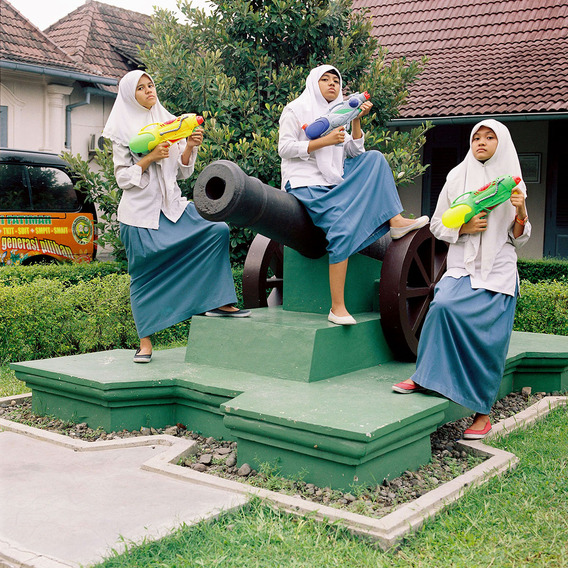-
From Current Issue
-
- Editor’s Letter Fire in the Heart
- Reviews I Gusti Ayu Kadek Murniasih
- Reviews 11th Seoul Mediacity Biennale: “One Escape at a Time”
- Dispatch Networked China
- One on One Monira Al Qadiri on Yukio Mishima
- Essays The rise of independent art spaces in pandemic-era Shanghai
- Features Tuan Andrew Nguyen
- Table of Contents
- Web Exclusives
- Archive
- Subscribe

R
E
V N
E
X
T
RANGGA PURBAYA, Stories Left Untold (detail), 2015, two digital prints with frames, 60 × 90 cm each. Courtesy the artist.
DECK, Singapore’s preeminent independent art space for photography, has inaugurated a series of researched-based exhibitions titled “Crossing SEA” which examine the development of Southeast Asian contemporary photography. To kick it off, DECK is presenting the group exhibition, “The History of Boys: The MES 56 and Beyond.”
MES 56 is Indonesia’s first contemporary photography collective, founded officially in 2002 in Yogyakarta. Its name is taken from the address of the group’s first outpost—and yes, its members are predominantly “boys,” many of whom studied at the state-run Indonesian Institute of the Arts, the first school in the country to offer a degree in photography. Drawn together by this training, the group coalesced, in part as a reaction against systematized expectations of what had for decades constituted “Indonesian photography.” Historically, those expectations were associated with salon portraiture, journalistic reportage and street photography, rather than aesthetics or conceptual intent.
In “History of Boys,” DECK featured eight MES photographers and three non-members tangentially connected with the group. The MES members are easy to identify: flickers of irony underlie many of their works, which often scrutinize facade and identity. The three non-members—Yaya Sung, Abednego Trianto, Agan Harahap—pursue further explorations into gender, recollection and truth.
Belanda Sudah Dekat! (The Dutch Are Already Near!) (2008), by Wimo Ambala Bayang, references Dutch colonialism as the shared history of Indonesia’s disparate ethnic, religious and social groups; body-builders, punks and schoolgirls brandish water guns in irreverent tableaux. The 2012 series “Green Hypermarket” by Edwin Roseno comprises five variously sized circular photographs of plants growing in corroded enamelware containers. Thriving despite the rust, Roseno’s fresh greenery is so flawless it appears artificial. In a twist on street photography, Jim Allen Abel’s Motorcycle Diaries (2016) amasses 100 rear-view mirrors, each of which frames a scene glimpsed by the artist while riding his motorcycle. Abel retains the distorting curvature of these “mirrored” images, which prompts the off-kilter illusion of gazing into multiple reflections.
Indonesia’s political legacies and oblique collective memory fuel much of the imagery at DECK. Agan Harahap harnesses social media as a platform to flirt with the anatomy of civil anxiety. Five decades after Indonesia’s communist purge, where perhaps as many as half a million were killed, a perceived leftist threat remains. Inspired by irrational overreaction to a reported communist resurgence, Harahap concocted The Story of a Fish (2016), an online synthesis of fake-news and perception involving a fish with a purported hammer-and-sickle pattern that rapidly devolved into a trenchant viral tease.
Memory, like truth, can be just as evasive. Tracing his grandfather’s disappearance during the purges, Rangga Purbaya sifts through stray—and reluctant—family recollections in the series “Stories Left Untold” (2015). His photograph Starting Point depicts a murky cave, where over 1,000 leftists were reputedly executed. Former photojournalist Yaya Sung meditates on personal histories mutated through violence, referencing violent demonstrations in 1997 and ’98 that preceded the fall of Suharto’s authoritarian regime. Sung’s restrained six-channel video installation And to Never, Never Forget: Kitchen Notes (2013) casts a serene gaze upon the mother of a protester murdered during those riots, quietly preparing her son’s favorite dishes.
In What Am I Going to Be When I Grow Up? (2015), artist Abednego Trianto contextualizes Indonesia’s entrenched gender issues; even today, polygamy persists in the Southeast Asian nation, and child brides are not uncommon. In 10 archival photographs of Javanese couples, the artist excises the faces, hands and feet of the women, then collages their disembodied facets of self-determination over the writings of an early Indonesian pioneer of women’s rights. The framed, double-sided works protruded from the wall like dominoes to cast complicated shadows. In a stab at modern social reform, a 1970s government directive tackled family planning with propaganda that included public wall-reliefs depicting the ideal two-child marital unit. Akiq Aw chronicles the remnants of those naive images in his series “Indonesian Family Portrait” (2014–16).
More personal elements define works by Dito Yuwono and Angki Purbandono. Interweaving notions of autonomy and alienation, Yuwano presents four lightboxes, collectively titled The Memories of Unidentified Experience (2014), that superimpose his medical X-rays over four hazy self-portraits. Purbandono’s installation Cosmic Axis Memories (2016) is a kaleidoscopic autobiography. Hundreds of transparencies—color and monochrome, vintage and modern—cascade from the ceiling in tiers, surrounding a core of light. Embodied in these intimate images of family and celebration is the spiritual cosmology of the artist’s life.
Self-referential, satirical and critical, the diverse works in “The History of Boys” redefine the “Indonesian photographer” as these 11 artists measure the country’s sociopolitical angst, its contradictory cultural personae, and its inconvenient histories. Fifteen years since the group’s formation, MES 56 and its associates are thriving; through the collective’s residencies, workshops and multidisciplinary projects, these image-makers have become a potent influence at the forefront of a uniquely Indonesian photographic discourse.
"The History of Boys: The MES 56 and Beyond” is on view at DECK, Singapore, until April 23, 2017.
To read more of ArtAsiaPacific’s articles, visit our Digital Library.









